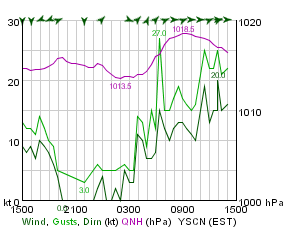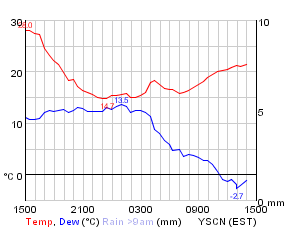Flying Training
Lesson 21: Circuits and Simulated Engine Failure
Saturday 15 April 2006, 7.00am with Kerry Scott in Citabria VH-MWY
Weather: clear and cool. Wind 230° at 12kt. RH 48%


No soccer this Saturday and next so I'm seizing the opportunity to take a couple of early morning flights. It was still dark when I was woken by the alarm at 5am, and when I stepped outside it was windy, as forecast, but clear. As before I checked the conditions using Weatherzone Buzzword, and like last week the wind was 230° at 10 knots. It's a funny thing though - I pulled up outside the hanger just after 6.20, and at exactly that moment a gust of wind came through at 27 knots. (It's that spike on the right.) It actually triggered a special report (the AWS reported at exactly 6.22 rather than on the half hour).
 I went ahead with the preflight anyway, and by the time we took off at about 7.15 the wind was back to
a more manageable 12 knots gusting to 15. I wasn't in WKM after all. MWY (Jim's blue Citabria) was there
and free so I used that. Jim told me it needed fuel, and trusted me to take it round there so I did another solo
taxi and managed not to bend it. I just did as he suggested and held a little into-wind aileron to stop the wind lifting
that side. The refuelling procedure is:
I went ahead with the preflight anyway, and by the time we took off at about 7.15 the wind was back to
a more manageable 12 knots gusting to 15. I wasn't in WKM after all. MWY (Jim's blue Citabria) was there
and free so I used that. Jim told me it needed fuel, and trusted me to take it round there so I did another solo
taxi and managed not to bend it. I just did as he suggested and held a little into-wind aileron to stop the wind lifting
that side. The refuelling procedure is:

- Grab the clipboard and credit card from the office.
- Taxi the plane over to the bowser and shut down.
- Check all switches are off (remember ROARS).
- Attach the earth lead to the tag or exhaust.
- Run the card through the machine.
- Grab the ladder, the fuel hose and the dipstick.
- With the hose over your shoulder, climb the ladder, undo the cap and dip the tank.
- Fill the tank up to around 50 litres. Don't lean the nozzle against the filler rim, as you may distort it.
- Dip the tank.
- Repeat with the other tank.
- Wind up the fuel hose and earth lead.
- Check the fuel quality at all four drain points.
- Fill out the sheet, including volume and cost.
- Return the sheet to the office.
 Like last week, Kerry had me check the ATIS, esp wind and runway in use, taxi to the
run-up bay (into wind, not facing the taxiway like the Cessna that was already there) and
then make the radio call at the hold point. CTAF this time: "Camden traffic, Citabria
Mike Whisky Yankee lining up and rolling runway two-four for circuits." As usual we
bounded into the air (the headwind helps!) and then commenced the first of several circuits.
I concentrated on keeping the climb to 70 knots and trimming, making the crosswind turn
square, levelling off at 1300 feet exactly and making a co-ordinated turn onto downwind.
I tried not to look at the runway till established on a heading (towards Chatswood again)
with wings level, and I checked that the jury strut was on the runway centreline.
Like last week, Kerry had me check the ATIS, esp wind and runway in use, taxi to the
run-up bay (into wind, not facing the taxiway like the Cessna that was already there) and
then make the radio call at the hold point. CTAF this time: "Camden traffic, Citabria
Mike Whisky Yankee lining up and rolling runway two-four for circuits." As usual we
bounded into the air (the headwind helps!) and then commenced the first of several circuits.
I concentrated on keeping the climb to 70 knots and trimming, making the crosswind turn
square, levelling off at 1300 feet exactly and making a co-ordinated turn onto downwind.
I tried not to look at the runway till established on a heading (towards Chatswood again)
with wings level, and I checked that the jury strut was on the runway centreline.
As we passed the threshold Kerry yanked the throttle back to idle and said, "Oh, we've lost the engine." and I had to trim for 60 knots and begin a gentle turn towards the runway. Because we were high and close this involved some sideslipping, using right aileron and left rudder, straightening up before landing. As you can see from Kerry's notes below, I'm still showing some symptoms of being 'ground-shy' and flaring too soon, and on at least one occasion I compounded this by then putting the nose down. Kerry didn't mince her words with this one on the debrief. She said, "DON'T put the nose down. If you do, you'll land on the mains first, turn it right round and probably wreck it, and then we won't be able to use it again." Right. So three-point landings aren't just a matter of professional pride; they're obviously an essential safety precaution, ie you get the tailwheel on the ground so you have some directional control.
And some of my landings were good. Not that Kerry is going to let it go to my head. After one landing where I didn't even notice the wheels touch the tarmac, Kerry said, "Luck!" (grinning).
The biggest problem we had was that a Citabria (not Curtis Aviation) joined the circuit ahead of us and took huge, wide scenic detours which required us to slow down to stay behind him, while still staying within gliding distance of the runway. Most of the time we kept close enough to require sideslips on final, (switching to left aileron and right rudder for the last three circuits, which Kerry says the aircraft prefers), but on the last one we took a longer than usual excursion (yes, still following that plane), and I said, "I don't think we're going to make the runway!". Kerry answered, "Well, let's see." and I concentrated particularly hard on keeping that glide at 60 knots. We got lower and lower to the high ground in front of runway 24, and blow me if we didn't just sneak over the last fence and reach the tarmac. OK, it was ahead of the piano keys but it was a tremendous confidence builder to know we could make it to the runway without an engine, so thanks Kerry for letting me glide all the way down to the ground.
We taxiied quickly off the runway as there was another Citabria (RRW I believe) on finals behind us. This is another area it's time to take responsibility for - situational awareness. It's particularly important in a non-towered circuit, though it's always the pilot's responsibility to maintain separation from other traffic. At one point we lost a Tomahawk that we knew was in the pattern, and Kerry made a call to ask where he was (what was the format of this call?), whereupon he responded, "Behind you!".
 Back in the office we were doing the paperwork and discussing the lesson
when I said to Kerry, "I could tell by your silences that I was either
doing it right or you were waiting to see just how far wrong I could
go," and she said with a laugh, "Exactly right!".
Back in the office we were doing the paperwork and discussing the lesson
when I said to Kerry, "I could tell by your silences that I was either
doing it right or you were waiting to see just how far wrong I could
go," and she said with a laugh, "Exactly right!".
Kerry also mentioned that she's taking time off in May and would like to see me solo before she goes, so it looks like I'm on the home straight to that particular milestone. I think the circuits are under control now, it's just that last bit just above the ground, which of course needs to be perfect every time (or at least within very tight limits).
Instructor's notes: "Radio (CTAF) + flying + glide approach. Iain flew more consistently & landings improved. Some inconsistency with flare."
Next lesson - more early morning circuits. I'm sometimes flaring too soon, so let's see if we can fix that [famous last words...].
